Tonto Basin Read online
A DEADLY SHADOW
The dark form of the rustler slipped out of sight over the embankment.
“Better go slow an’ careful,” warned Greaves. “An’ only go close enough to call Somers. Mebbe that damn’ half-breed Isbel is comin’ like some Injun on us.”
Jean heard the soft swish of footsteps through wet grass. Then all was still. He lay flat, with his cheek on the sand, and he had to look ahead and upwards to make out the dark figure of Greaves on the bank. One way or another he meant to kill Greaves. If he arose and shot the rustler, that would defeat his plan. Jean wanted to call softly to Greaves—You’re right about the half-breed!—and then, as he wheeled aghast, to kill him as he moved. But it suited Jean to risk leaping up on the man. Jean did not waste time in trying to understand the strange, deadly instinct that gripped him at the moment, but he realized he had chosen the most perilous plan to get rid of Greaves.
Jean drew a long, deep breath and held it. He let go of his rifle. He rose silently, as a lifting shadow. He drew the Bowie knife....
Other books by Zane Gray:
RANGLE RIVER
THE DESERT CRUCIBLE
TOP HAND
THE WESTERNERS
THE GOLDEN WEST (Anthology)
WOMAN OF THE FRONTIER
RANGERS OF THE LONE STAR
LAST OF THE DUANES
THE RUSTLERS OF PECOS CITY
SPIRIT OF THE BORDER
THE BUFFALO HUNTER
LAST RANGER
The characters and events portrayed in this book are fictitious. Any similarity to real persons, living or dead, is coincidental and not intended by the author.
Copyright © 2004 by Zane Grey, Inc.
Tonto Basin first appeared under the title “To the Last Man” as a ten-part serial in The Country Gentleman (5/28/21-7/30/21).
Copyright © 1921 by The Curtis Publishing Company.
Copyright © renewed 1949 by Lina Elise Grey.
Copyright © 2004 by Zane Grey, Inc., for restored material.
All rights reserved.
No part of this book may be reproduced, or stored in a retrieval system, or transmitted in any form or by any means, electronic, mechanical, photocopying, recording, or otherwise, without express written permission of the publisher.
Published by AmazonEncore
P.O. Box 400818
Las Vegas, NV 89140
ISBN-13: 9781477833285
ISBN-10: 1477833285
This title was previously published by Dorchester Publishing; this version has been reproduced from the Dorchester book archive files.
Contents
Foreword
Chapter One
Chapter Two
Chapter Three
Chapter Four
Chapter Five
Chapter Six
Chapter Seven
Chapter Eight
Chapter Nine
Chapter Ten
Chapter Eleven
Chapter Twelve
Chapter Thirteen
Chapter Fourteen
FOREWORD
by
Jon Tuska
I grew up in a small town in Wisconsin and for the first ten years of my life lived in a back apartment half a block from the local public library. You had to be ten years of age before you could borrow books from the adult section of the library. When I turned ten and was able to enter the adult stacks, I chose to withdraw two books: The Bishop Murder Case (Scribner, 1929) by S. S. Van Dine and The Lone Star Ranger (Harper, 1915) by Zane Grey. I recall that I wondered if the story in The Lone Star Ranger was anything like The Lone Ranger to which I listened on the radio. It wasn’t. In fact, it was something of a disappointment because Jennie Lee, the heroine, was of particular interest to me and halfway through the story she vanished, never to return. Decades passed before I found her again.
It was while trying to put together an accurate filmography for Zane Grey, providing the correct literary source for each of the 109 films based on his work, that I was confronted by the problem of Last of the Duanes. It had been filmed four times, but there was no such novel. I pursued the matter with Loren Grey, the younger son of Zane Grey and president of Zane Grey, Inc. As far as he knew, there had been such a novel, but it had never been published, somehow having been transformed into The Lone Star Ranger upon publication. “Is there a manuscript?” I asked. Loren wasn’t certain, but he promised that he would search. Eventually, he did locate his father’s handwritten manuscript in the bottom drawer of a file cabinet in the Zane Grey, Inc. room where it had survived for eighty years.
The task, then, was to reconstruct what had happened. In the early years Zane Grey’s novels were serialized in pulp magazines, prior to publication by Harper & Bros. Grey had written a long serial titled “The Last of the Duanes” and sent it to editor Bob Davis at The Argosy, one of the pulp magazines published by The Frank A. Munsey Company. Davis had previously bought serial rights to a number of Grey’s early novels. This time Davis was shocked to find, upon reading this story, that eighteen persons were killed in the course of it. He considered this much too violent to publish. What he agreed to do was to run a drastically abbreviated version that appeared as “The Last of the Duanes” in a single installment in The Argosy (9/14).
When it came time to offer the book to Harper & Bros., Grey had lost faith in the original story as he had written it. The book that emerged as The Lone Star Ranger, therefore, is for about the first 200 pages the manuscript of “The Last of the Duanes” and is called “Book I: The Outlaw.” The remainder of the novel, called “Book II: The Ranger,” is actually the second half of the serial “The Lone Star Rangers” from All-Story Cavalier Weekly (5/9/14–5/23/14). Apparently Ripley Hitchcock, Grey’s editor at Harper & Bros., rewrote the second half of “The Lone Star Rangers,” changing it from a first-person narrative into a continuation and conclusion of the hybrid novels titled by him The Lone Star Ranger. Since neither story had appeared in anything resembling what Zane Grey had written, it was finally possible to publish each for the first time in book form as the author had intended: Last of the Duanes (Leisure Books, 1998) and Rangers of the Lone Star (Leisure Books, 1999).
I urged Loren Grey to tell me of any other manuscripts by his father that had met a similar fate. There were, he said, the sections in what became 30,000 on the Hoof (Harper, 1940) that dealt with Lucinda Huett’s rape by a renegade Apache and the decision made by Logan and Lucinda Huett to keep the child and raise him as if he were their own. It is this half-Apache son who alone of the Huetts’ sons survives the Great War, returns to the ranch, and proves able to save it. The story was finally published in its entirety as Woman of the Frontier (Leisure Books, 2000). Finally, Loren said, he had the complete typescript of his father’s major novel set in the back country of Australia that had been cut to a third of its length, ostensibly because of the paper shortage, when it was published as Wilderness Trek (Harper, 1944). It was restored to its full length as The Great Trek (Five Star Westerns, 1999).
If this sort of thing had happened so often, what, then, of those novels rightly regarded as classics: Riders of the Purple Sage (Harper, 1912) and its sequel, The Rainbow Trail (Harper, 1915)? Zane Grey, Inc. did not have the original holographic manuscripts of these. They had been variously donated by Lina Elise Grey, Zane Grey’s widow, to various archives. The holographic manuscript for The Rainbow Trail was located in the Special Collections of the Brigham Young University Library. Upon examination, it was found to be significantly different from the published book, especially with regard to the fate of young Fay Larkin, who was forced into a marriage with a Mormon who already had five wives and fifty-five children, and who in time gives birth to a son. The Harper & Bros, edition would have the reader believe Fay Larkin remained a virgin while being held captive in a Mormon town for sealed wives! Critics of Zane Grey, in fact, have singled out this incident as a primary indication that Grey was a hopelessly romantic writer incapable of historical realism. Now to refute them, The Desert Crucible (Leisure Books, 2004) has finally been published as the author wrote it. The changes and alterations in Riders of the Purple Sage are even more drastic and alter the entire perspective of the story. Retaining its original title, the restored version of this novel will appear as a Leisure Western in 2006.
Zane Grey is not the only American novelist who has had to stand by and watch his work altered, rewritten, changed by the hands of others. William Faulkner’s third novel, and the first in his series of novels about the characters and milieu of Yoknapatawpha County, Sartoris (Harcourt, Brace, 1929), was rejected by Faulkner’s original publisher, Horace Liveright, and after numerous other rejections was only accepted provisionally by Alfred Harcourt if it was mercilessly cut. Irving Howe and other Faulkner critics have always dismissed Sartoris as inferior work, but this was singularly due to the fact that the book Faulkner wrote and loved and felt to be his finest to that date was never published in anything like the form he had intended. This had to wait until the appearance of Flags in the Dust (Random House, 1973), the restored Sartoris, and now a key book for understanding the lives and times of not only the Sartoris family, including Aunt Jenny, but Horace and Narcissa Benbow and local members of the Snopes clan.
The cuts demanded by Alfred Harcourt to Sartoris were dictated, according to the underlying correspondence, by a desire to focus the story exclusively on the Sartoris family. The changes made to the novel titled Tonto Basin were of a different kind. At the root of the longstanding feud between the Jorths and the Isbels is a woman w
e never meet, a character dead before the story opens, Ellen Sutton. She was engaged to Gaston Isbel at the time of the outbreak of the War Between the States. While Isbel was away on active duty, Ellen Sutton took up with the disreputable Lee Jorth and they have a child out of wedlock. They never marry; only live together. The child is Ellen Jorth. It is Lee Jorth who tells his daughter how her mother taunted Gaston Isbel when he came back from the war with the sexual relationship she had with Jorth, and how it was this that enraged Isbel and began the feud between the two of them. The burden of having been born of infidelity is one that oppresses Ellen Jorth for most of the novel. The story was serialized as “To the Last Man” in The Country Gentleman (5/28/21–7/30/21) and much of this background was excised from the story, leaving a reader baffled as to the source of the passion and hatred in a feud that eventually claims every family member on both sides except for Ellen Jorth and Jean Isbel, the mixed-blood Nez Percé.
Yet, were a reader to believe that censorship in American letters is now something in the distant past, I would disagree. This kind of editorial intervention has only changed its political and moral guise over time; otherwise, it is as powerful and pervasive as ever. When Jane Candia Coleman submitted I, Pearl Hart to a major New York publisher in 1997, she was told the novel could not be published as she had written it. Although her story was based on the real Pearl Hart, a woman who committed a daring stagecoach robbery and was sent to Yuma Territorial Prison as a result, the editor wanted several prison scenes added, graphically detailing Pearl’s sexual activities with various female inmates. Since nothing of the kind happened to Pearl Hart, the author refused to change history to satisfy any editor. I, Pearl Hart (Leisure Books, 2000) was eventually published exactly the way the author intended, true to the character, to her time, and to the land. I believe authors of literary fiction deserve the freedom to tell a story according to their own standard of artistic truth, to listen unhindered to their muse, and to share with us what they have learned. Tonto Basin now at last is published as Zane Grey wanted his story to appear.
Chapter One
At the end of a dry, uphill ride over barren country, Jean Isbel unpacked to camp at the edge of the cedars where a little rocky cañon, green with willow and cottonwood, promised water and grass. His animals were tired, especially the pack mules that had carried a heavy load, and with slow heaves of relief they knelt and rolled in the dust. Jean experienced something of relief himself as he threw off his chaps. He had not been used to hot, dusty, glaring days on the barren lands. Stretching his long length beside a tiny rill of clear water that tinkled over the red stones, he drank thirstily. The water was cool, but it had an acrid taste—an alkali bite that he did not like. Not since he had left Oregon had he tasted clear, sweet, cold water, and he missed it just as he longed for the stately shady forests he had loved. This wild endless Arizona land bade fair to earn his hatred.
By the time he had leisurely completed his tasks, twilight had fallen and coyotes had begun their barking. Jean listened to the yelps and to the moan of the cool wind in the cedars with a sense of satisfaction that these lonely sounds were familiar. This cedar wood burned into a pretty fire and the smell of its smoke was newly pleasant.
“Reckon maybe I’ll learn to like Arizona,” he mused, half aloud. “But I’ve a hankerin’ for waterfalls an’ dark green forests. Must be the Indian in me.… Anyway, Dad needs me bad, an’ I reckon I’m here for keeps.”
Jean threw some cedar branches on the fire, in the light of which he opened his father’s letter, hoping by repeated reading to grasp more of its strange portent. It had been two months in reaching him, coming by traveler, by stage and train, and then by boat, and finally by stage again. Written in lead pencil on a leaf torn from an old ledger, it would have been hard to read even if the writing had been more legible.
“Dad’s writin’ was always bad, but I never saw it so shaky,” said Jean, thinking aloud.
Grass Valley, Arizona
Son Jean:
Come home. Here’s your home and here you’re needed. When we left Oregon, we all reckoned you’d not be long behind. But it’s four years now. I’m growing old, Son, and you was always my steadiest boy. Not that you ever was so darn steady. Only your wildness seemed more for the woods. You take after Mother, and your brothers Bill and Guy take after me. That’s the red and white of it. You’re part Indian, Jean, and that Indian I reckon I’m going to need bad.
I’m rich in cattle and horses, and my range here is the best I ever seen. Lately we’ve been losing stock. But that’s not all nor so bad. Sheepmen have moved into the Tonto and are grazing down in Grass Valley. Cattlemen and sheepmen can never bide in this country. We have bad times ahead. Reckon I’ve more reasons to worry and need you, but you must wait to hear that by word of mouth.
Whatever you’re doing, chuck it and rustle for Grass Valley so to make here by spring. I’m asking you to take pains to pack in some guns and a lot of shells. And hide them in your outfit. If you meet anyone when you’re coming down into the Tonto, listen more than you talk. And last, Son, don’t let anything keep you in Oregon. Reckon you have a sweetheart, and if so fetch her along. With love from your Dad,
Gaston Isbel
Jean pondered over this letter. Judged by memory of his father, who had always been self-sufficient, it had been a surprise and somewhat of a shock. Weeks of travel and reflection had not helped him to grasp the meaning between the lines.
“Yes, Dad’s growin’ old,” mused Jean, feeling a warmth and a sadness stir in him. “He must be ‘way over sixty. But he never looked old.… So he’s rich now an’ losin’ stock, an’ goin’ to be sheeped off his range. Dad could stand a lot of rustlin’, but not much from sheepmen.”
The softness that stirred in Jean merged into a cold, thoughtful earnestness that had followed every perusal of his father’s letter. A dark, full current seemed to flow in his veins, and at times he felt it swell and heat. It troubled him, making him conscious of a deeper, stronger self, opposed to his careless, free, and dreamy nature. No ties had bound him in Oregon, except love for the great still forests and the thundering rivers, and this love came from his softer side. It had cost him a wrench to leave. All the way by ship down the coast to San Diego, and across the Sierra Madres by stage, and so on to this last overland travel by horseback, he had felt a retreating of the self that was tranquil and happy, and a domination by this unknown somber self, with its menacing possibilities. Yet, despite a nameless regret and a loyalty to Oregon, when he lay in his blankets, he had to confess a keen interest in his adventurous future, a keen enjoyment of this stark wild Arizona. It appeared to be a different sky stretching in dark, star-spangled dome over him—closer, vaster, bluer. The strong fragrance of sage and cedar floated over him with the campfire smoke, and all seemed drowsily to subdue his thoughts.
At dawn he rolled out of his blankets and, pulling on his boots, began the day with a zest for the work that must bring closer his calling future. White, crackling frost and cold, nipping air were the same keen spurs to action that he had known in the uplands of Oregon, yet they were not wholly the same. He sensed an exhilaration similar to the effect of a strong, sweet wine. His horse and mule had fared well during the night, having been much refreshed by the grass and water of the little cañon. Jean mounted and rode into the cedars with gladness that at last he had put the endless leagues of barren land behind him.
The trail he followed appeared to be seldom traveled. It led, according to the meager information obtainable at the last settlement, directly to what was called the Tonto Rim, and from there Grass Valley could be seen down in the Tonto Basin. The ascent of the ground was so gradual that only in long, open stretches could it be seen. But the nature of the vegetation showed Jean how he was climbing. Scant, low, craggy cedars gave place to more numerous, darker, greener, bushier ones, and then to high, full-foliaged, green-berried trees. Sage and grass in the open flats grew more luxuriously. Then came the piñons, and presently among them the checker-barked junipers. Jean hailed the first pine tree with a hearty slap on the brown, rugged bark. It was a smooth dwarf pine struggling to live. The next one was larger, and after that came several, and beyond them, pines stood up everywhere above the lower trees. The odor of pine needles mingled with the other dry smells that made the wind pleasant to Jean. In an hour from the first line of pines he had ridden beyond the cedars and piñons into a slowly thickening and deepening forest. Underbrush appeared scarce except in ravines, and the ground in open patches held a bleached grass. Jean’s eye roved for sight of squirrels, birds, deer, or any moving creature. It appeared to be a dry, uninhabited forest. About midday Jean halted at a pond of surface water, evidently melted snow, and gave his animals a drink. He saw a few old deer tracks in the mud and several huge bird tracks new to him that he concluded must have been made by wild turkeys.

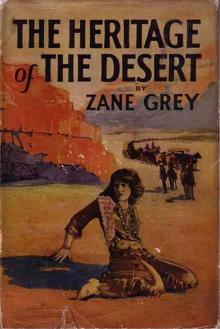 The Heritage of the Desert: A Novel
The Heritage of the Desert: A Novel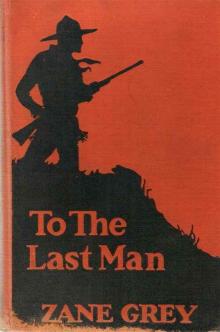 To the Last Man
To the Last Man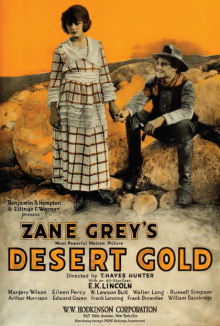 Desert Gold
Desert Gold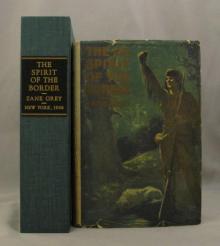 The Spirit of the Border: A Romance of the Early Settlers in the Ohio Valley
The Spirit of the Border: A Romance of the Early Settlers in the Ohio Valley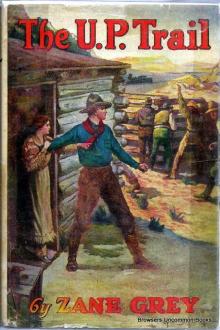 The U. P. Trail
The U. P. Trail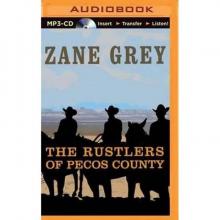 The Rustlers of Pecos County
The Rustlers of Pecos County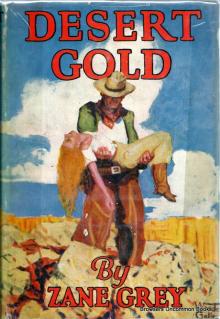 The Border Legion
The Border Legion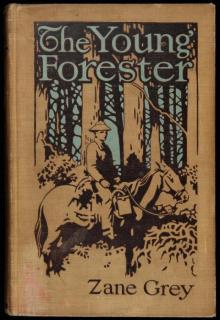 The Young Forester
The Young Forester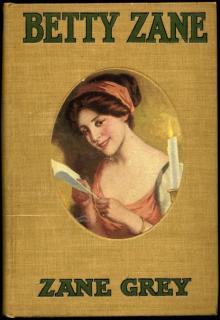 Betty Zane
Betty Zane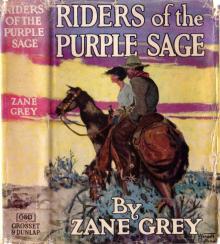 Riders of the Purple Sage
Riders of the Purple Sage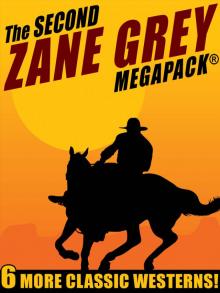 The Second Zane Grey MEGAPACK®
The Second Zane Grey MEGAPACK®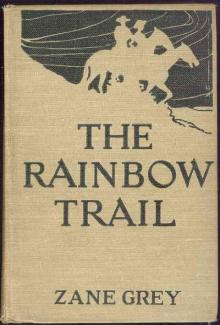 The Rainbow Trail
The Rainbow Trail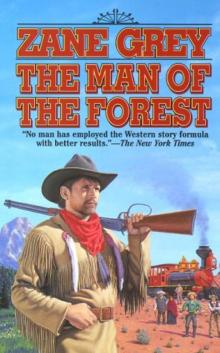 The Man of the Forest
The Man of the Forest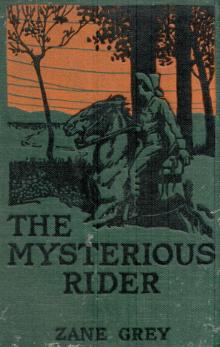 The Mysterious Rider
The Mysterious Rider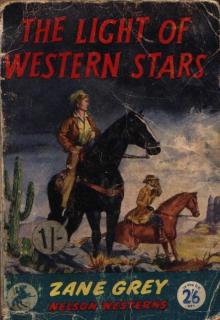 The Light of the Western Stars
The Light of the Western Stars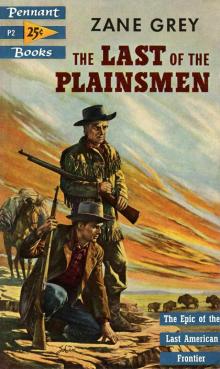 The Last of the Plainsmen
The Last of the Plainsmen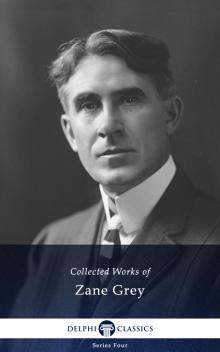 Collected Works of Zane Grey
Collected Works of Zane Grey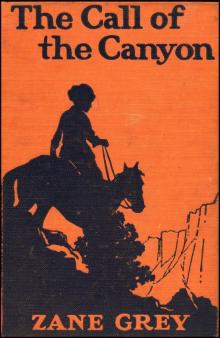 The Call of the Canyon
The Call of the Canyon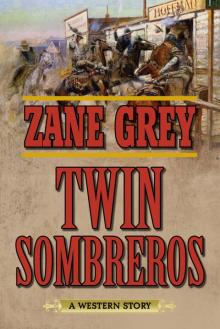 Twin Sombreros
Twin Sombreros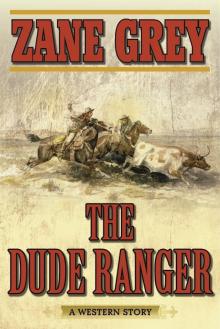 The Dude Ranger
The Dude Ranger The Water Hole
The Water Hole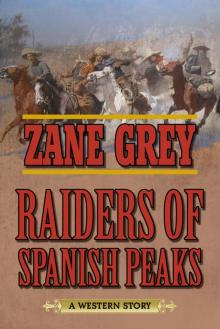 Raiders of Spanish Peaks
Raiders of Spanish Peaks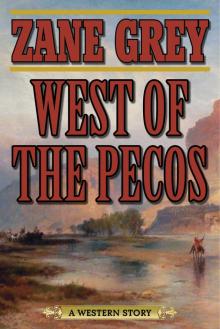 West of the Pecos
West of the Pecos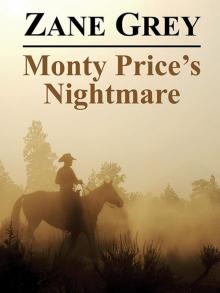 Monty Price's Nightmare
Monty Price's Nightmare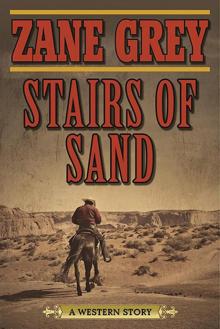 Stairs of Sand
Stairs of Sand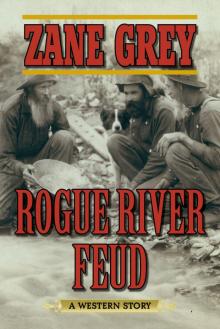 Rogue River Feud
Rogue River Feud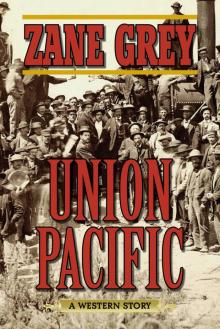 Union Pacific
Union Pacific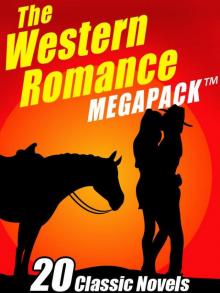 The Western Romance MEGAPACK ®: 20 Classic Tales
The Western Romance MEGAPACK ®: 20 Classic Tales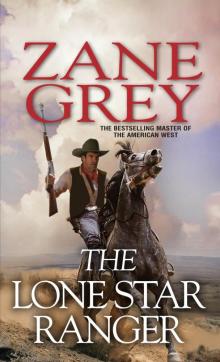 The Lone Star Ranger
The Lone Star Ranger The Zane Grey Megapack
The Zane Grey Megapack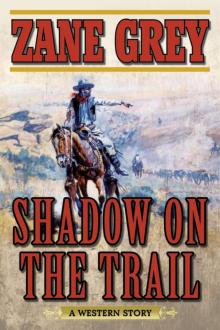 Shadow on the Trail
Shadow on the Trail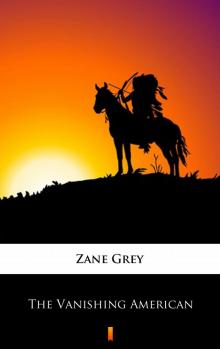 The Vanishing American
The Vanishing American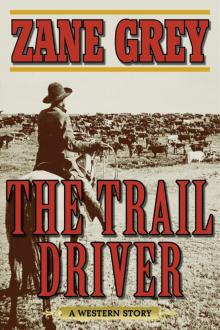 The Trail Driver
The Trail Driver War Comes to the Big Bend
War Comes to the Big Bend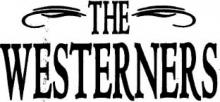 The Westerners
The Westerners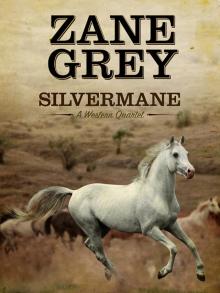 Silvermane
Silvermane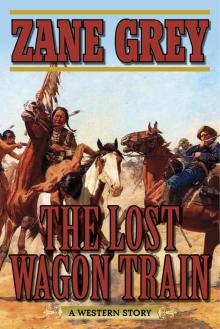 The Lost Wagon Train
The Lost Wagon Train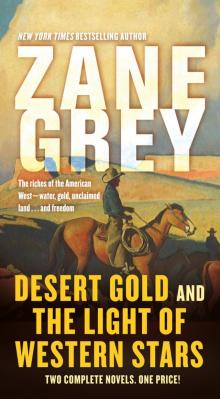 Desert Gold and the Light of Western Stars
Desert Gold and the Light of Western Stars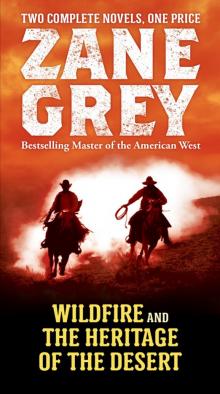 Wildfire and the Heritage of the Desert
Wildfire and the Heritage of the Desert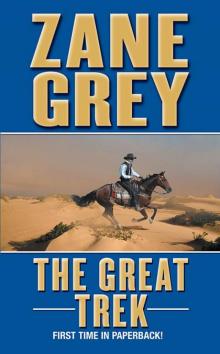 The Great Trek
The Great Trek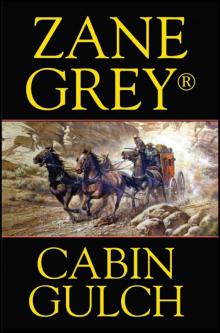 Cabin Gulch
Cabin Gulch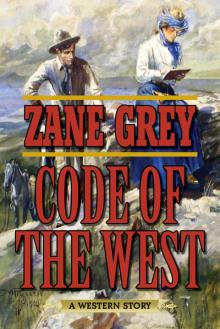 Code of the West
Code of the West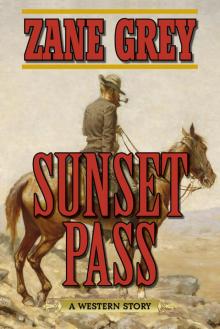 Sunset Pass
Sunset Pass Panguitch
Panguitch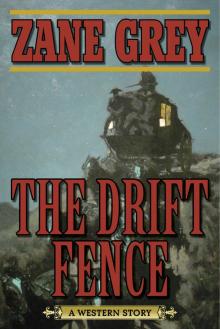 The Drift Fence
The Drift Fence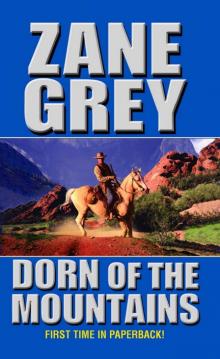 Dorn Of The Mountains
Dorn Of The Mountains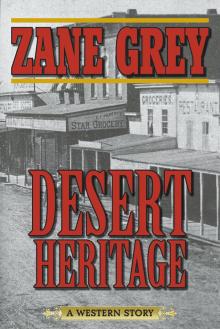 Desert Heritage
Desert Heritage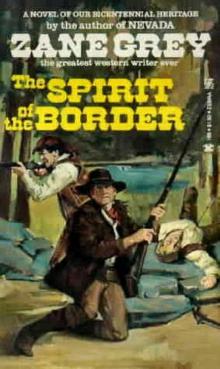 The Spirit Of The Border
The Spirit Of The Border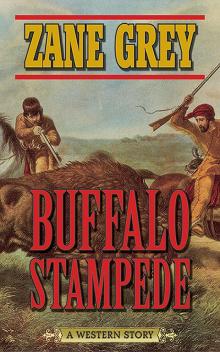 Buffalo Stampede
Buffalo Stampede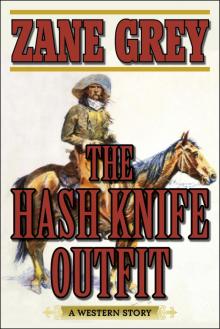 The Hash Knife Outfit
The Hash Knife Outfit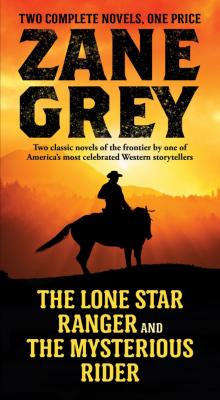 The Lone Star Ranger and the Mysterious Rider
The Lone Star Ranger and the Mysterious Rider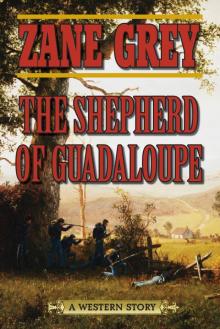 The Shepherd of Guadaloupe
The Shepherd of Guadaloupe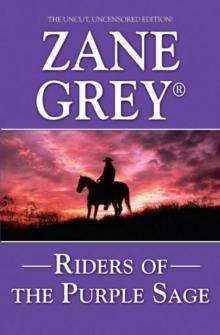 Riders of the Purple Sage (Leisure Historical Fiction)
Riders of the Purple Sage (Leisure Historical Fiction)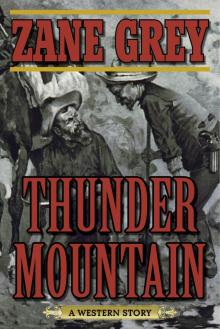 Thunder Mountain
Thunder Mountain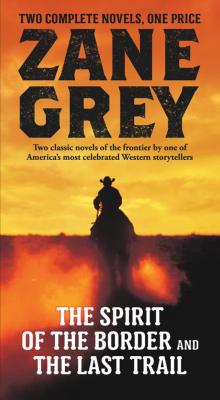 The Spirit of the Border and the Last Trail
The Spirit of the Border and the Last Trail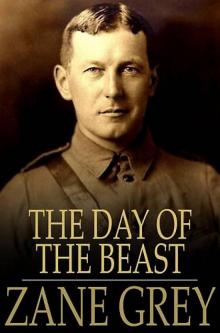 The Day of the Beast
The Day of the Beast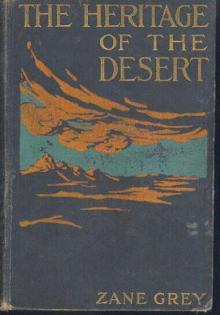 The Heritage of the Desert
The Heritage of the Desert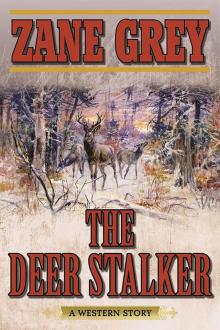 The Deer Stalker
The Deer Stalker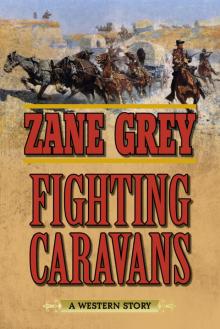 Fighting Caravans
Fighting Caravans